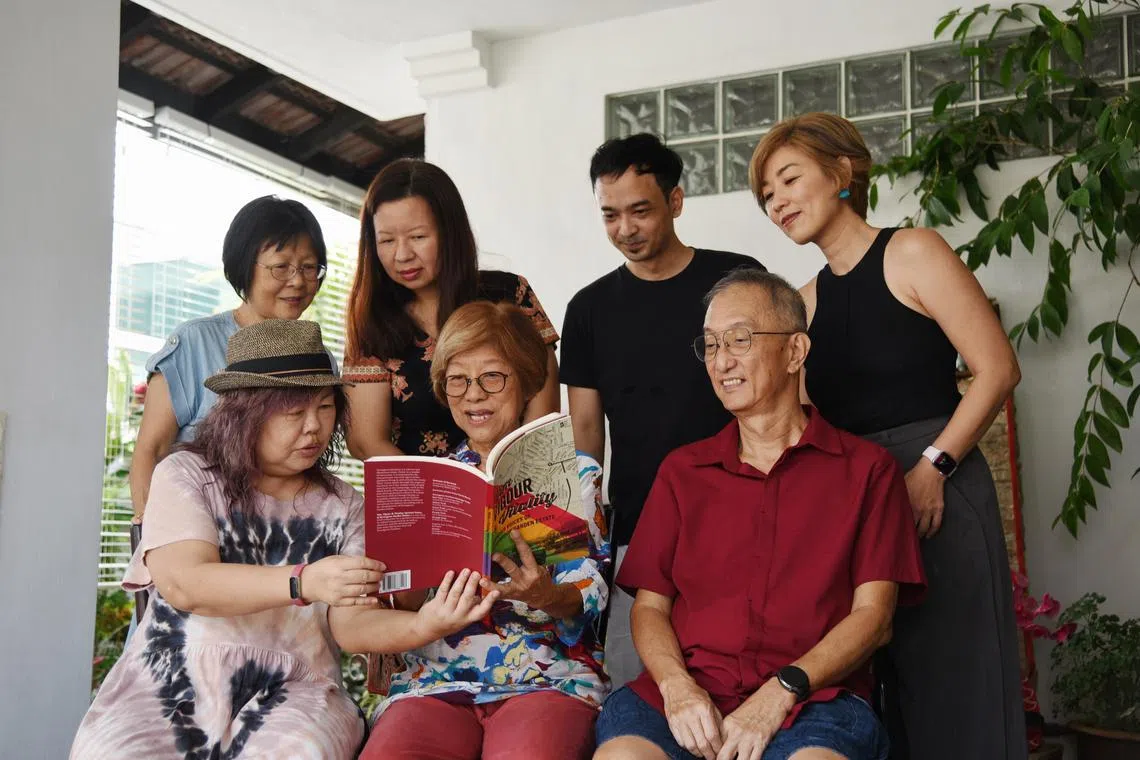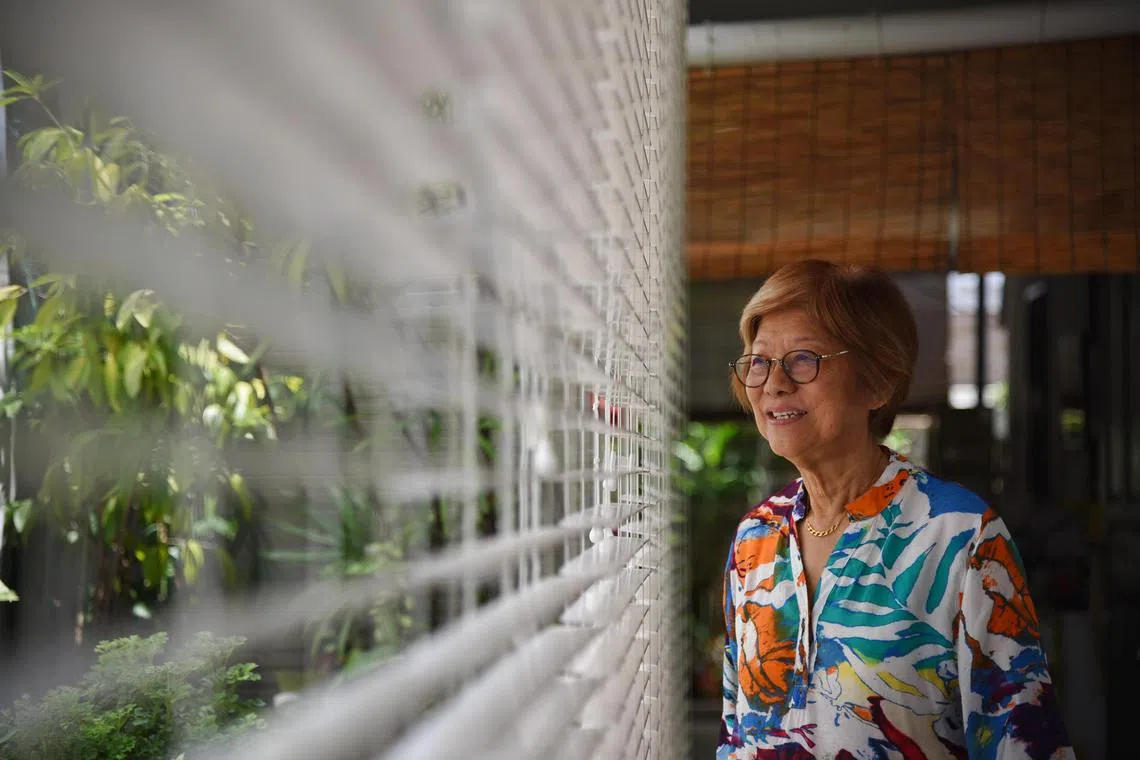Laid back yet bustling: Charm and character of Serangoon Gardens captured in book by residents
Sign up now: Get ST's newsletters delivered to your inbox

Retired principal Mabel Wee (bottom row, second from the left), author of 'Vim, Vigour & Vitality: Spirited Voices of Serangoon Garden Estate' with some of her volunteers for the book.
ST PHOTO: HENG YI-HSIN
Follow topic:
SINGAPORE – It was during the Covid-19 pandemic when retired principal Mabel Wee spent more time in her neighbourhood in Serangoon Gardens, and fell in love with it again.
“I went around walking, street by street, and rediscovered the beauty of this estate and the uniqueness of every home here,” said the 74-year-old former principal of Geylang Methodist School (Primary), who has lived in her single-storey semi-detached home with her family for 70 years.
In 2020, she decided to put together a book on Serangoon Gardens in celebration of its 70th anniversary in 2024.
“This is probably the last thing I could do for my community,” said Ms Wee, who invested $40,000 of her savings in the book project.
She had no problem getting help from her neighbours to fulfil her colossal dream. Eight volunteers who share her passion for their neighbourhood stepped forward.
Ms Ngiam May Ling, a 51-year-old compliance professional, said: “The pandemic rekindled our love for our estate. We realised we did not need to go out of Serangoon Gardens for all that we need.”
She added: “It has the laid-back feel of an English village, and the French and Australian communities here make it more cosmopolitan.”
Mr Chan Kwong Lok, a 69-year-old retired university administrator, said: “It’s quiet and peaceful, and yet it only takes five to 10 minutes to find the bustle, like the Chomp Chomp Food Centre, market and other amenities.”
It took them three years to do research, conduct interviews and complete the writing.
On Feb 17, the book – Vim, Vigour & Vitality: Spirited Voices of Serangoon Garden Estate – will be launched at Serangoon Gardens Country Club. The 160-page book in English documents the voices of existing and former residents and shop owners, as well as the developments that shaped the estate. There are also photographs of the old estate, houses and shops to show the changing landscape, including images of kampungs.
Ms Catherine Khoo, a 64-year-old publisher and adviser of the project, confessed that she did not have much faith in the ground-up project at first, as none of the team are in the writing profession.
“I think Mabel’s leadership as a retired principal helped her see the big picture, put the concept together, and get everything done,” Ms Khoo said. “I’m proud of her and the team.”
For Ms Loh Hui Meng, 67, a freelance early childhood educator, the project was an educational journey.
“I’ve learnt so much about this place. It is the microcosm of Singapore and parallels how the nation has developed and progressed.”

Ms Mabel Wee (fourth from the left) and some of her volunteers (from left) Ms Loh Hui Meng, Ms Ngiam May Ling, Ms Joey Kwa, Ms Wee, Mr Chan Kwong Lok, Ms Catherine Khoo, and Mr Leon Yzelman.
ST PHOTO: HENG YI-HSIN
Serangoon Gardens is one of the oldest private housing estates in Singapore. It was built during the post-war period to meet the demand for landed properties, like other estates such as Braddell Heights, Sennett, Frankel and Sembawang.
Before the 1950s, the area was home to rubber plantations that were eventually replaced by vegetable farms and flower gardens, which led to the naming of the estate as Serangoon Gardens.
Much of Serangoon Gardens was developed in the 1950s after the British reoccupied Singapore in 1945. Roads such as Bodmin Drive and Brighton Crescent were named after locations in the United Kingdom, and the estate was dubbed “Little UK”.
British property developer Stephen Cecil Macey was behind the development of Serangoon Gardens estate.
His son Charles William David Macey penned the book’s foreword.
He wrote that his late father would have been overwhelmed by the interest in the history of Serangoon Gardens.
“More important than that, the financial security and community” arising from his foresight, he added.
The estate is bounded by the central expressway, Ang Mo Kio Ave 3, Yio Chu Kang Road and Ang Mo Kio Ave 1. It comprises largely terrace and semi-detached houses and bungalows.
The heart of the estate is Serangoon Garden Circus, the centre of commercial, commuting and culinary activities. This is also the iconic roundabout where vehicles would enter from Lorong Chuan and Serangoon Garden Way.
Architectural designer Leon Yzelman, 36, has lived in the neighbourhood for 35 years. He did his master’s dissertation, Changing Face Of Serangoon Gardens, in 2013 at the National University of Singapore.
He noted that established retail chains have replaced many traditional shops. Several condominium developments like Kensington Park and Haus@Serangoon Garden have also injected new life into the area.
“Serangoon Gardens is evolving, but yet it is still the same global city in the suburbs, with its unique charm and character,” he said.

In 2020, Ms Mabel Wee decided to put together a book on Serangoon Gardens in celebration of its 70th anniversary in 2024.
ST PHOTO: HENG YI-HSIN
One of the things Ms Wee enjoys is the unmistakable neighbourliness or kampung spirit that binds the residents.
“Gatherings and house parties are common. The mothers will support each other with grocery shopping or looking after the kids,” she said. “Residents who have moved abroad and out of the estate continue to keep in contact over Facebook and WhatsApp, and some are flying back for the book launch.”
Said Ms Ngiam: “Amidst all the changes, its gotong royong (mutual help) spirit has remained intact. I know that if I ever run out of eggs, a neighbour will surely lend me some.”
The book is priced at $54 nett, and will be on sale at the Serangoon Gardens Country Club on Feb 17 at 3pm. It can also be purchased on https://www.catherinekhoo.sg/estore/product/vim-vigour-vitality-spirited-voices-of-serangoon-garden-estate

